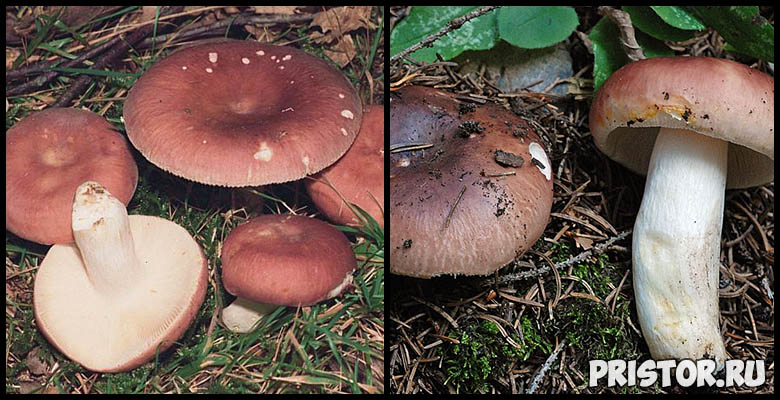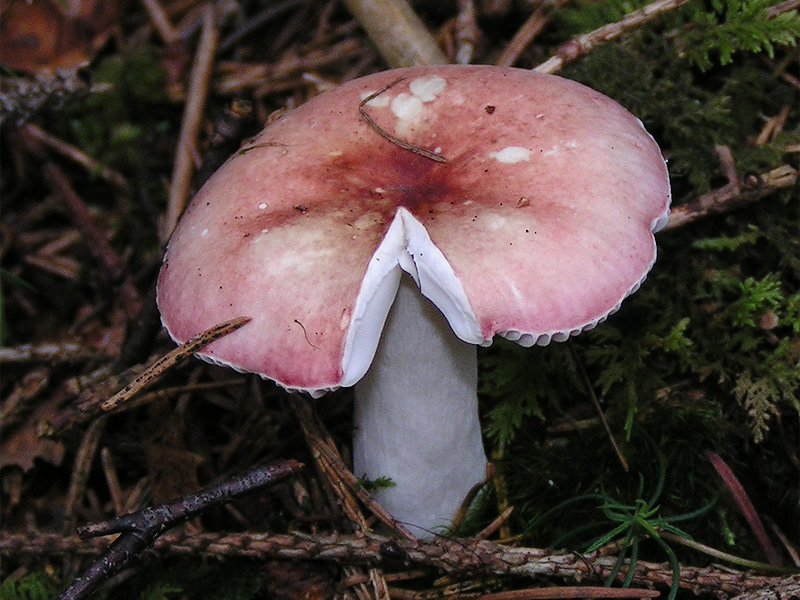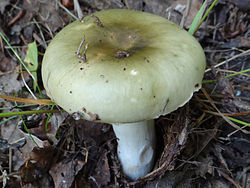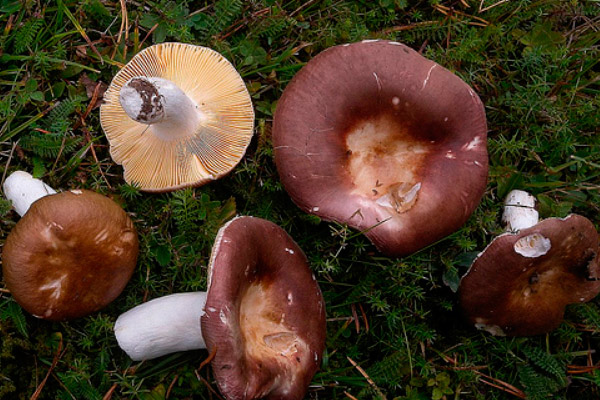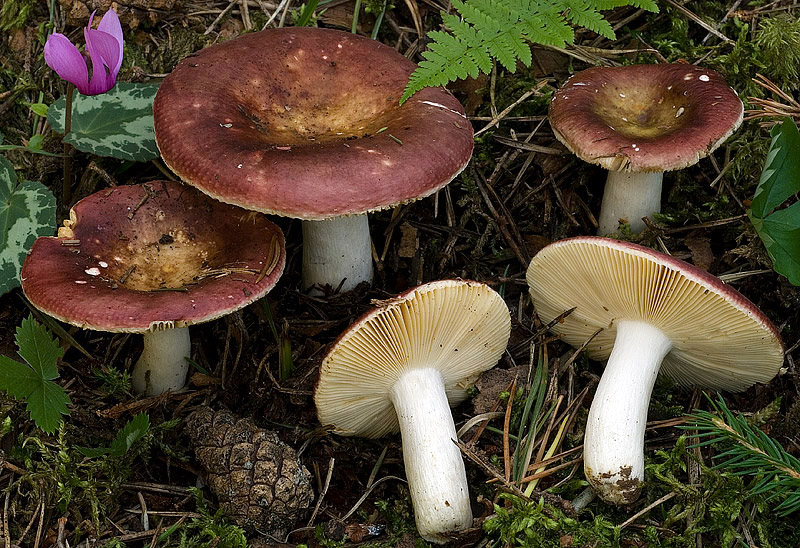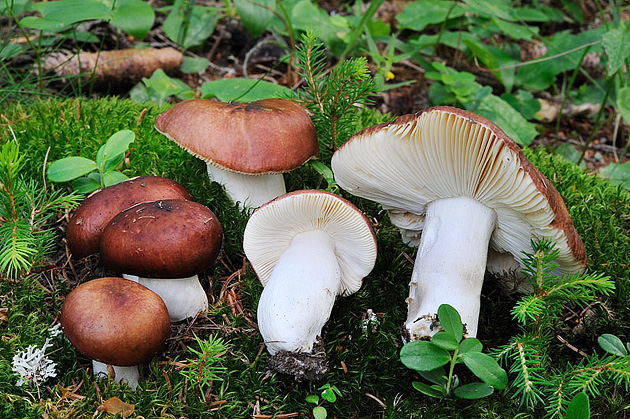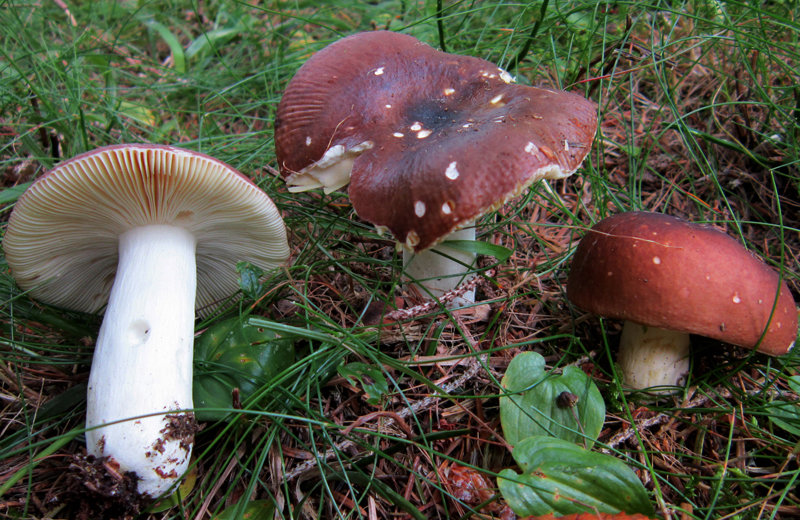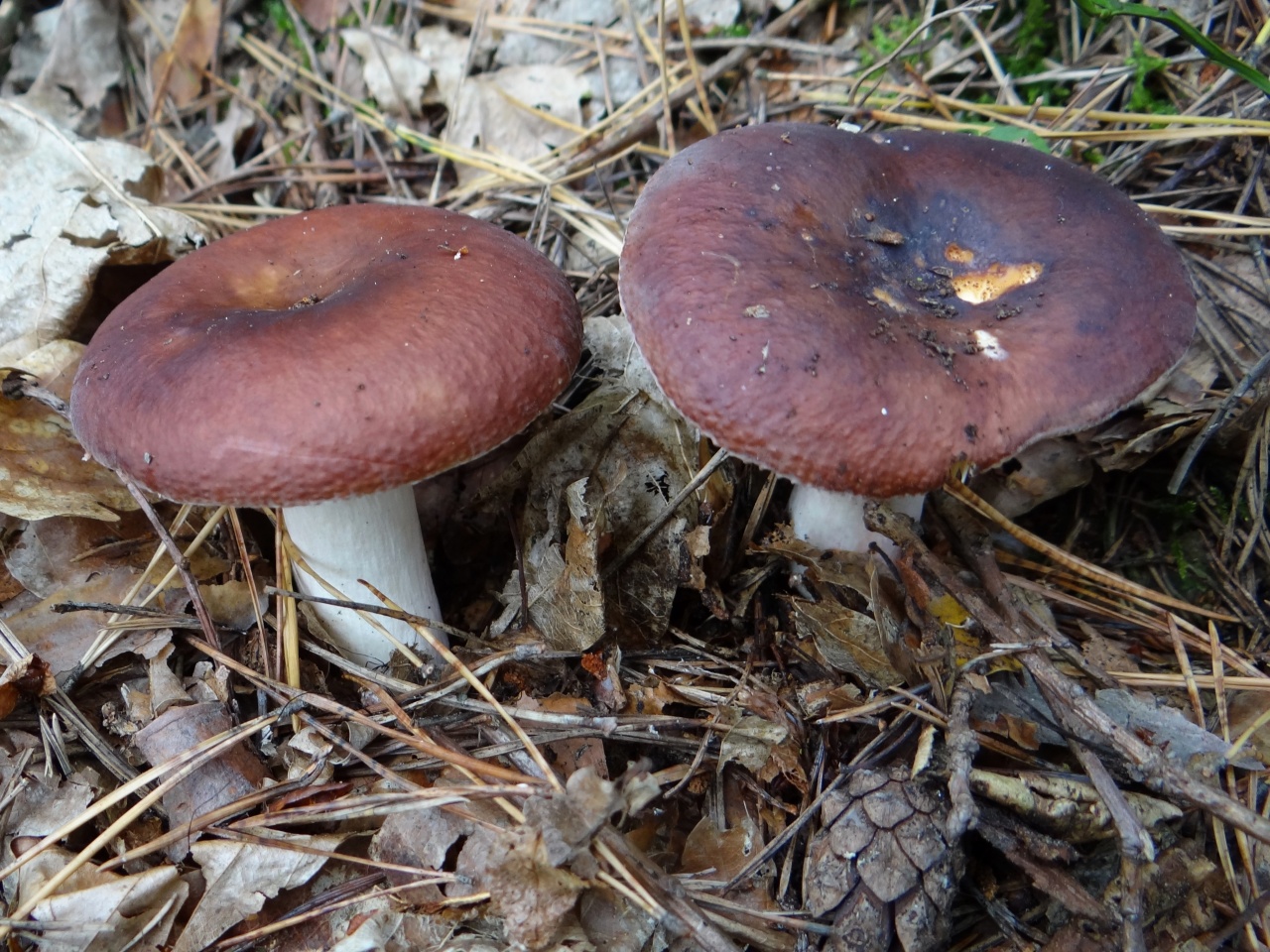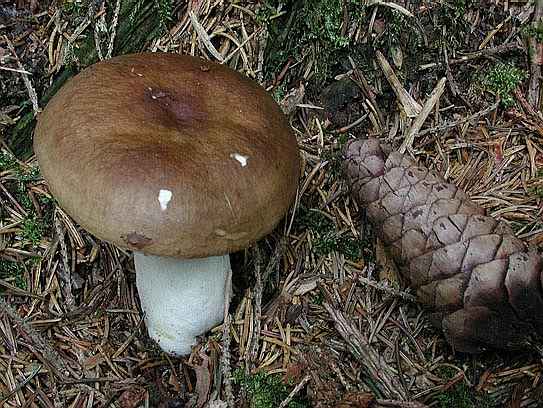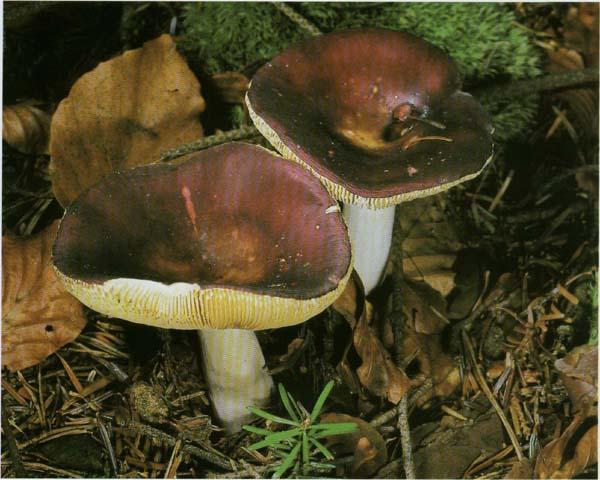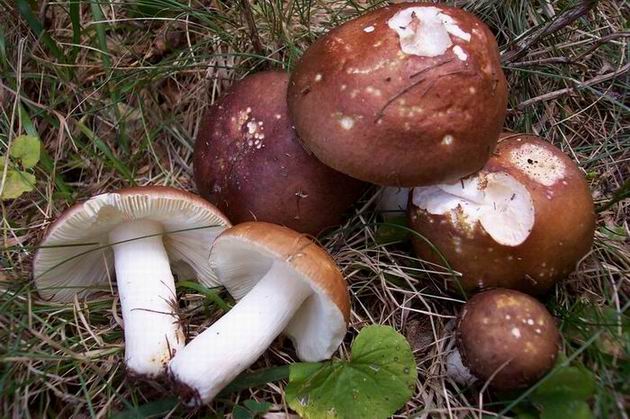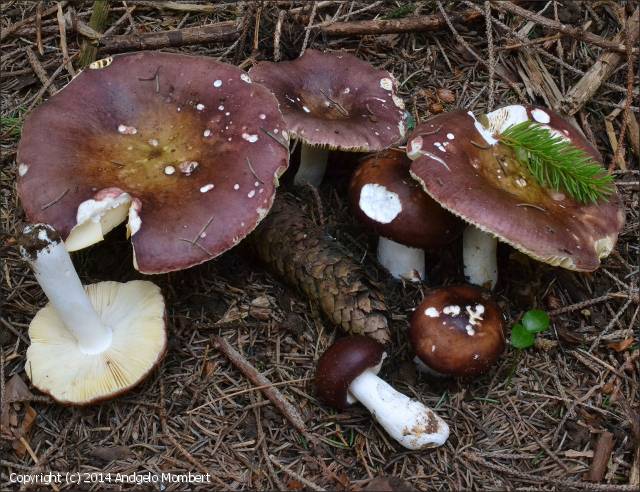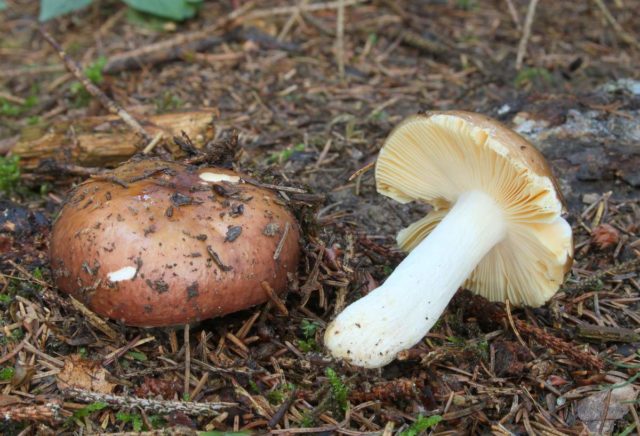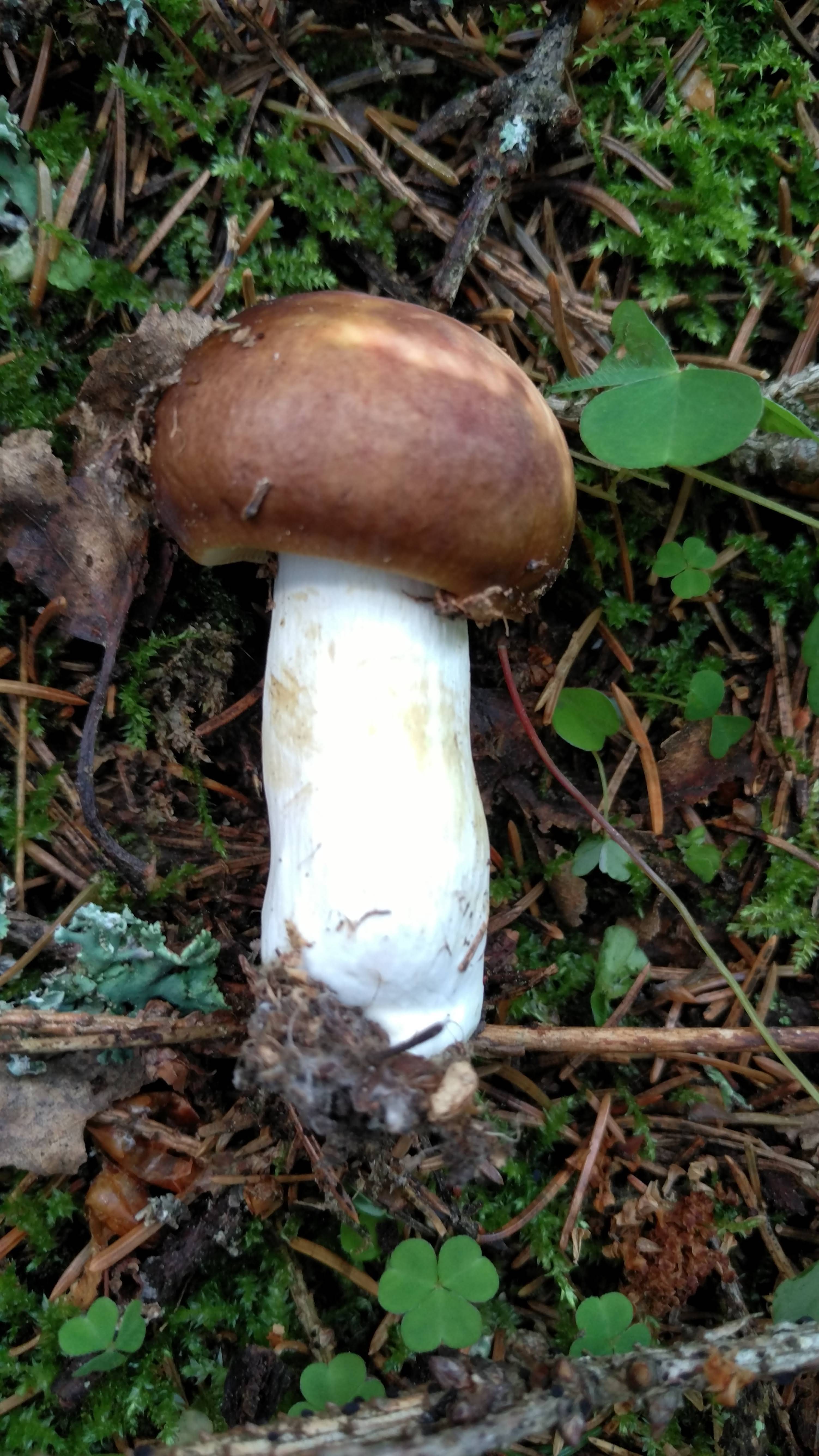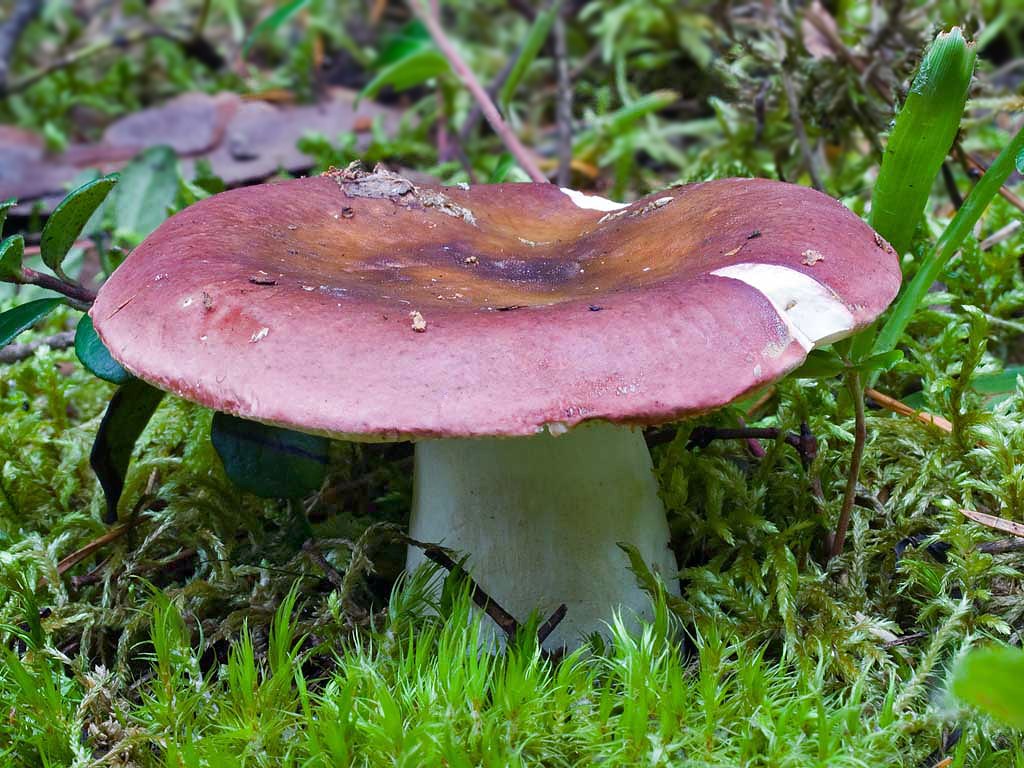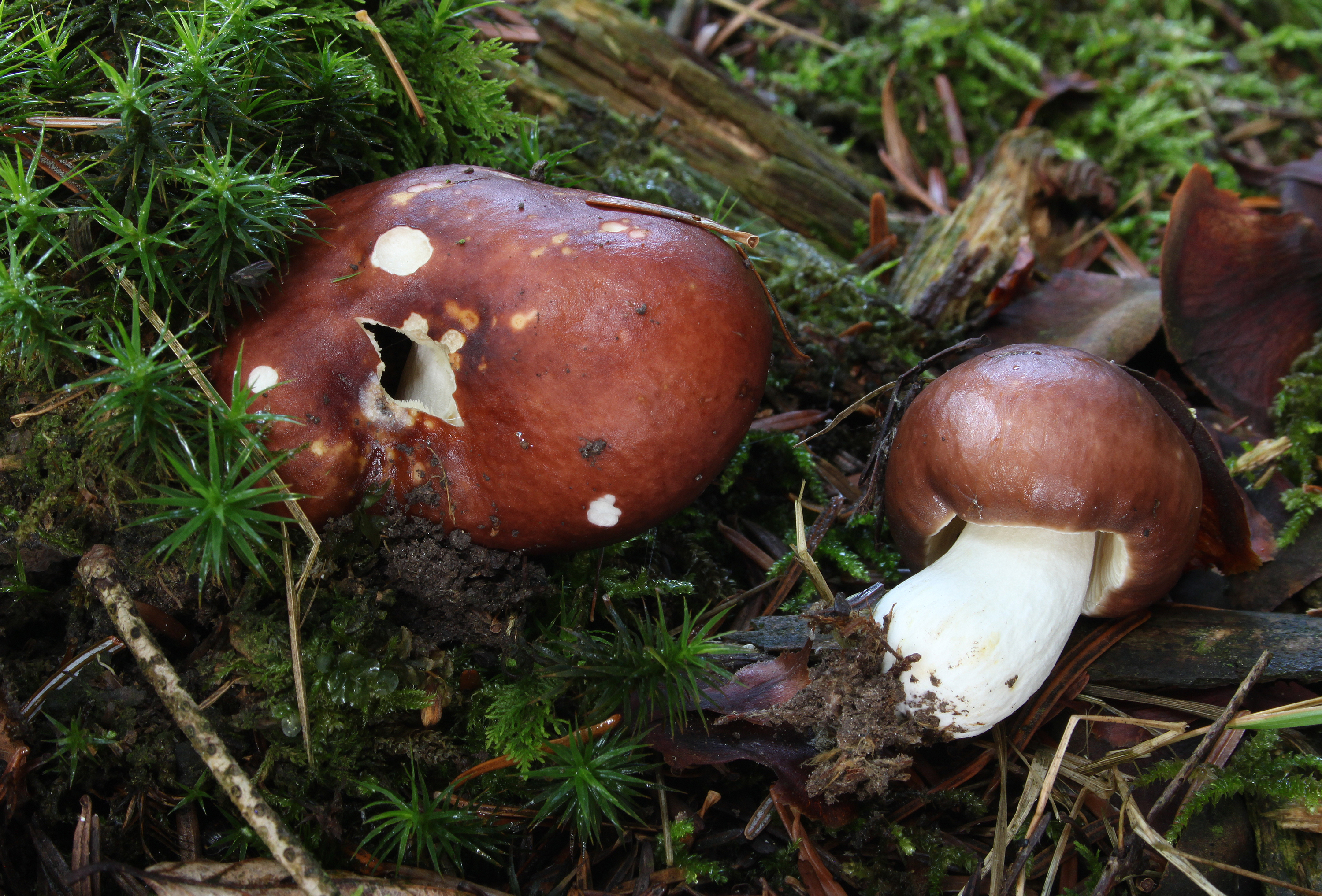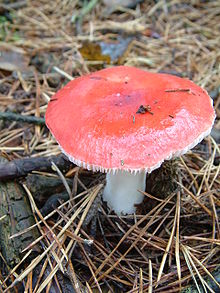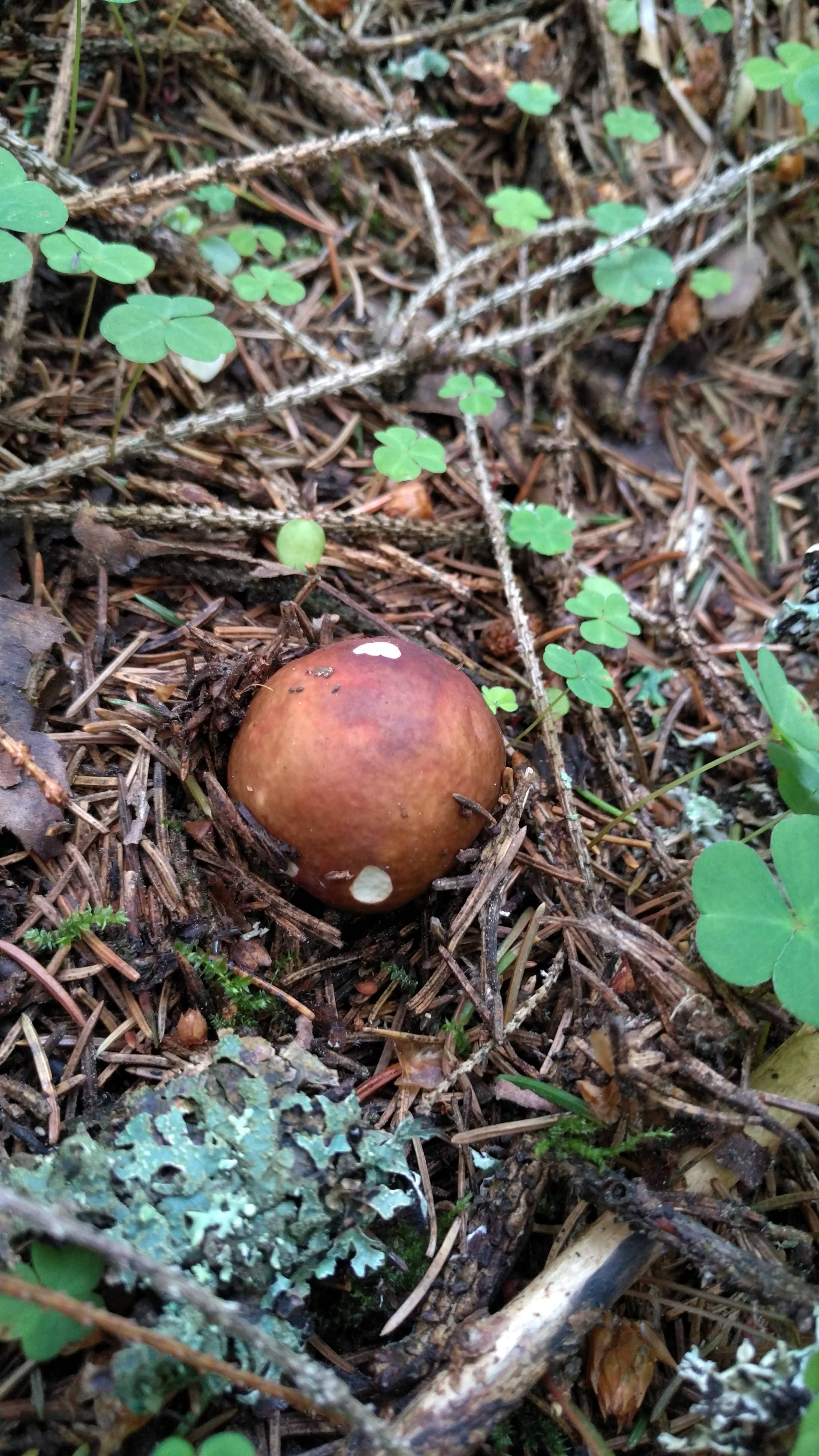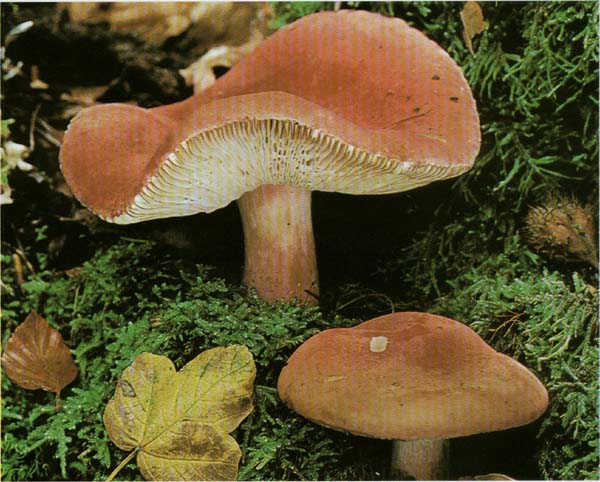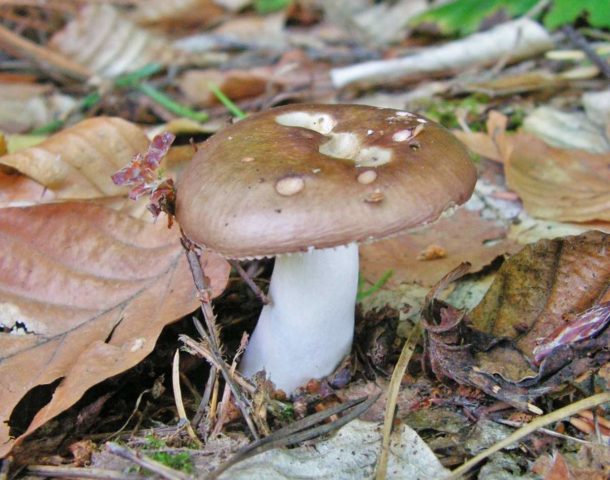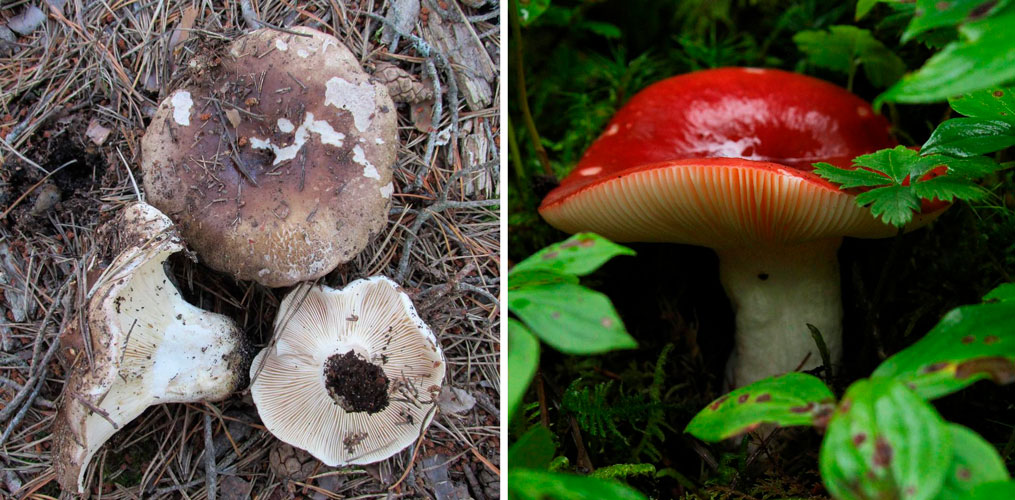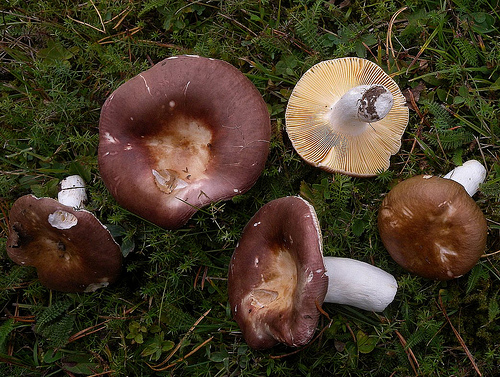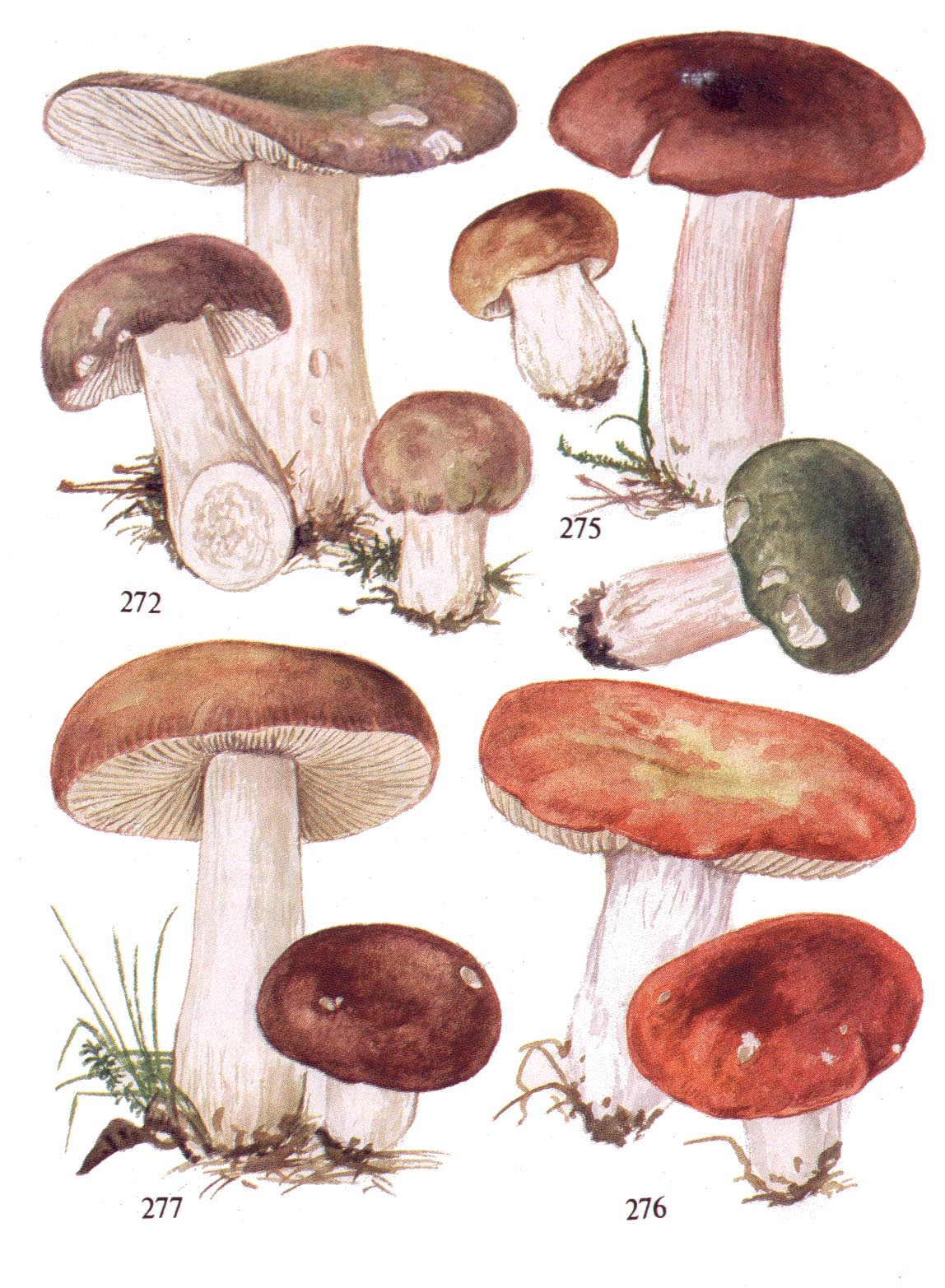Whole russula
In another way, the fungus is called brown-red russula, wonderful russula or flawless russula.
External characteristics
Mushroom cap
The wonderful russula has a medium-sized hat that grows about 40-120 cm in diameter. The young mushroom has a convex hat in the form of a hemisphere, the adult becomes flat, with a dimple in the center and wavy, grooved and occasionally cracking edges.
"Hats" are covered with a sticky, glossy, poorly removable skin. It turns red - brownish, brownish, dark red, and the middle is often yellow - olive, sometimes fades and turns white.
The hats are filled with white, fragile flesh without a special smell, at first sweetish in taste, later acquiring spicy notes.
The hat bottom is filled with dense thick plates, free or growing to the legs. Young plates are painted in white or creamy tone, more mature ones acquire an ocher or cream color.
The russula flawless reproduces pale ocher spores.
Stipe
Whole russula has a cylindrical stem that grows about 30 mm in thickness and 100 mm in length. The legs of young mushrooms are filled with tight pulp. As they grow older, the center of the foot acquires a spongy structure.
The stem is painted pure white or with a pinkish blush and yellow spots at the base.
Whole russula - lat Russula integra
Places of growth and fruiting
These russula prefer soils rich in limestone and thrive in deciduous forests and conifers, including highlands.
Fruiting is rare, group, lasts from July to early October.
Similar species
Edible
- Russula golden-red. It features a brick hat, shaded with a purple tone, and tasteless and odorless pulp.
- Brown russula. Its surface has a red-violet color, and the flesh smells like herring: the older the mushroom, the stronger the smell.
- Russula green-red. It features a red-brown hat with a pale olive center, tasteless pulp and rich ocher shades.
Conditionally edible
The russula is burning. This mushroom has a scarlet hat, occasionally with a yellowish center, as well as white, like snow, accrete plates and pulp with a burning acrid taste.
Whole russula belongs to the third category edible mushrooms. It is better to use young specimens for culinary purposes, cleaning them from debris and rinsing them. Young mushrooms are good fried, stewed or salted.
Description of russula whole
The cap of the whole russula, like that of its relatives, is hemispherical at the initial stage, but over time it becomes prostrate, with a depressed center. Its diameter varies from 4 to 12 centimeters. The color of the cap is blood red, and the central part is brownish or olive yellow. The cap is dense, slimy. The sticky skin peels off with ease. The edges of the cap are wavy and cracking.

The pulp is tender and very brittle. The color of the pulp is white. The pulp tastes sweet, and then becomes spicy. The plates are forked-branched, yellow or light gray in color. There is a light pink bloom on the leg, and yellow spots at its base.
The variability of russules wonderful
The color of the cap of the remarkable russula changes, it can be yellow-brown, olive, blood-red, dark brown and brown-purple. The legs of young specimens are solid, but with age, the pulp in them becomes spongy, and after the legs become flat. In young mushrooms, the flesh is white, and with age it often becomes yellow-brown. The plates are initially white, but as they grow, they turn yellow.
Places of distribution and time of fruiting of whole russula
Great russula grow in mountain coniferous and deciduous forests.They prefer calcareous soils. These mushrooms settle in groups. Whole russula bear fruit from summer to autumn - in July-October.

Variety of species
By their nature, russula are so diverse, but at the same time similar to each other that sometimes even experts cannot reliably attribute any mushroom to one or another species.

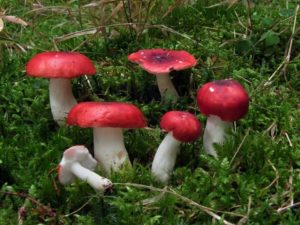
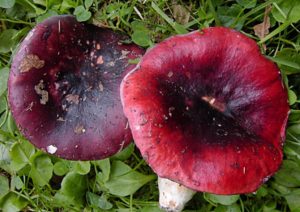

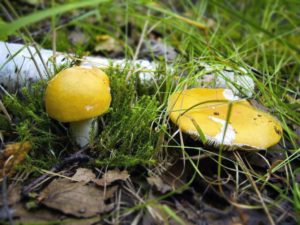
There are 750 species of russula in total, which greatly complicates the matter, but there are still criteria by which a person can navigate in the family of these mushrooms. Of course, these are external characteristics.

The color of the cap and legs, plates and spores is a rather convenient thing that instantly catches the eye, but even with it, only 20-30 species are easily distinguished, while over the rest you have to rack your brains and resort to chemical analysis.

On the territory of Russia, you can find about 60 representatives of the russula family.

Most people who are fond of picking mushrooms or seriously study them divide russules into three categories:
- edible;
- slightly edible;
- poisonous.
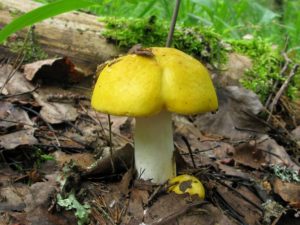


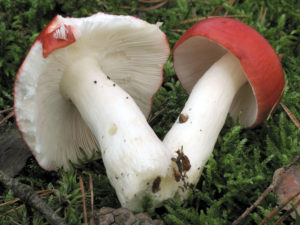


If the cap is too bright, the color of the pulp gradually changes during cooking, and the mushroom itself exudes an unpleasant odor, it is better to bypass the suspicious object.

Russula mushroom - photo and description
Despite their diversity and individual properties of species, all russules have a similar structure and similar external characteristics, differing only in the color of the cap, which with age turns from rounded to flatter with raised brims.

Its diameter can reach up to 15 cm, and the color varies from more natural tones (green and brown) in edible mushrooms to bright and eye-catching (red) in poisonous ones.

Here and further in the article, you can see a photo of the russula mushroom and see for yourself how different the individual representatives of this family are from their fellows.

For greater deceit, on the caps of some russules, you can see small yellow spots, and to the touch they are completely different depending on the weather - both dry and sticky. The skin on them, as a rule, is matte and shiny, easily separating from the pulp, which is an undoubted advantage when cooking.

However, in addition to the different-colored hats, russula also differ in the color of the legs and plates. Their color is light, ranging from white to yellow tones, as is the color of spore powder. Sometimes pink shades are found, but only in poisonous individuals.


Types of russula mushrooms
Among the species of russula, there are such mushrooms that we do not call that. If not in the know, then these include:
- value, or fists;
- black podgruzdki, or blackies;
- blackening podgruzda, or russula blackening;
- podgruzdki white;
- loadings are greenish.
The listed mushrooms are edible, only before use it is recommended to soak in two or three waters to avoid a pungent taste. In appearance and properties, these representatives of the mushroom kingdom are similar to the Millers, although they belong to the russula family.
Inedible
Immediately, we note the inedible species of russula, of which there are not so many. These mushrooms are not poisonous, but the bitterness they contain gives the right to classify them as conditionally edible. The pungent taste is removed by some types of pre-processing: soaking or boiling, but eating raw is out of the question.
A uniting quality in inedible russula, they are also incorrectly called false, bright, as if screaming about danger. But as mentioned above, after appropriate processing, the mushrooms are edible.
The rest of the mild-tasting russula can indeed be eaten raw, but don't do it because of the potential confusion over the mushroom mix.
Let's list the edible russula with a brief description:

Description and biology of russula
The russula belongs to the family of the russula from the order of the Russulovs, in Latin russulus is reddish.These are lamellar mushrooms in their youth with a rounded cap, which gradually straightens with the growth of the fruiting body.
The leg, reaches a height of 10 centimeters, without any growths like a ring or a volva, more often cylindrical and only in some species slightly pointed. Fungus plates are adherent frequent, white or yellowish.
The pulp of the mushroom is dense with age, it becomes fragile, soft, pleasant taste, although some types of russula are pungent, so they are even considered poisonous.
If we briefly describe what russula look like, then these are multi-colored mushrooms on white, rarely painted in other colors, legs. In terms of color, these cheerful mushrooms represent the entire color palette.
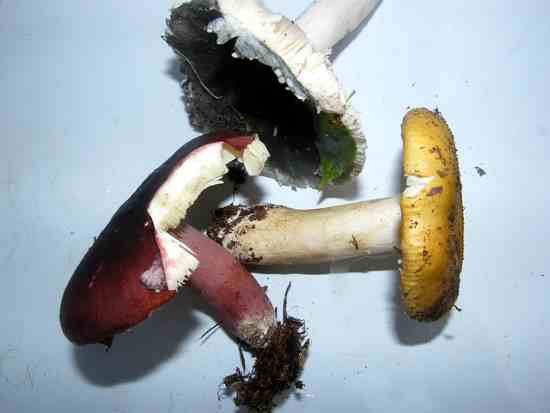
The size of russula caps reaches 25 centimeters in diameter.
The number of open species of russula is huge, Wikipedia gives the number - 257, 60 of which are found on the territory of Russia.
Russula grow in deciduous, mixed and coniferous forests, forming a symbiosis with trees: from birch to spruce.

Flawless russula taste
The russula flawless is an edible mushroom. According to its taste, it was assigned the 3rd category. These mushrooms can be eaten fresh or salted.
Similar species
Whole russula can be confused with other types of russula, but they have a spicy or peppery taste. This mushroom looks like a green-red russula.
Other mushrooms of this genus
Scaly russula is an edible mushroom. The diameter of its cap is 5-15 centimeters. At first, the shape is hemispherical, but with age, a depression forms in the center, and the edges rise up. The color of the cap is green or gray-green. The edges of the cap are slightly torn, the skin is removed up to half of the cap. The leg is white, dense.

Scaly russula grow in deciduous forests, choosing areas with acidic soil. These mushrooms are harvested from summer to autumn. Outwardly, this mushroom bears a resemblance to the poisonous pale toadstool, so care must be taken when collecting.
Black russula is a conditionally edible mushroom. The diameter of its cap ranges from 5 to 15 centimeters, and the shape changes from convex to funnel-shaped. The color of the cap is dark brown. The surface of the cap is slightly sticky. The leg reaches a height of 3-6 centimeters, while the diameter is quite large - 2-3 centimeters. In structure, the leg is dense, and in color it coincides with the cap. When touched, the leg turns black.
Black russula grow under the pines. They prefer acidic soils. Fruiting from July to October, but not too abundant. They grow mainly in the northern regions. In terms of taste, they belong to the 4th category, they are suitable exclusively for salting. The taste of salty russules is sweet and pleasant.

Similar species
Other types of russules of red tones are similar to whole:
- edible brown (Russula xerampelina). It is painted in a deep red-violet color, has a herring smell, which intensifies with age.
- edible green-red (Russula alutacea), which has an overall reddish-brown cap color often combined with a light olive central area. It is distinguished from the whole by free bright ocher plates and insipid taste.
- edible golden-red (Russula aurata) with a brick-colored hat, often with an admixture of purple. The pulp is odorless, the taste is insipid.
- inedible stinging (Russula emetika) with a rich scarlet cap, sometimes yellowing in the center, snow-white plates adhered to the stem and a sharp taste corresponding to the specific name.
Dangerous russula
Where did the name "russula" come from? This is a delicious food mushroom that can not only be fried and stewed, but also eaten raw, while being careful. But among russules there are also inedible species.
All inedible russules are distinguished by their reddish or bright red caps. And in many European sources they are generally referred to as poisonous.
Pungent russula is most common. It grows everywhere throughout the fall and summer, among swamps, in mixed and deciduous forests.It looks like a swamp russula, but you can distinguish it by its brighter red cap. The skin is removed from the pungent russula in one motion, and the reddish flesh is exposed. The pulp is fragile and very brittle.

The name russula suggests that mushrooms can be eaten raw, but edible species should be distinguished from poisonous ones.
Blood-red russula is also inedible. It grows in the fall in coniferous forests. The skin, in general, cannot be removed from her cap. Her leg is reddish, and the plates are descending.
There are several other types of inedible russula that all taste bitter and pungent. They all have pink caps of various shades and reddish legs. As noted, there are many types of russula, but mushroom pickers do not need to know all of their names, they just need to distinguish between inedible red-footed species.
Description
Russula golden received its specific name due to the clear yellow subtone of the color of the entire fruit body.
Hat
The size of the cap varies from 4 to 9 cm in diameter. With maturation, its shape changes from hemispherical to flat and then centrally depressed. Young specimens have smooth edges, and old ones are striated (a hymenophore layer appears).
The color of the cap is of all shades of red, and at a young age, red color predominates in mushrooms of this species, and yellowness appears more and more in maturity. The central cap is almost always colored in shades of yellow. The surface is variable to the touch depending on humidity: in the absence of precipitation - dry, in rainy weather - sticky.
Leg
The russula golden has an even-cylindrical stem with a rough-scaly surface. The leg is painted white, sometimes yellowish, and turns brown in mature mushrooms. Inside, the leg never contains a cavity and has a cotton-like consistency. In mature mushrooms, it acquires a distinct porosity. The dimensions of the leg are from 3 to 8 cm in height and from 1 to 2 cm in thickness.
Spore powder
The spores are egg-shaped and fairly large. Their surface is bumpy and reticulate. The bulk of the spore powder is white.
Spore-bearing layer
The plates are of moderate thickness, can be located both often and not very much. Multiple bifurcation of the plates is usually observed. Their color is initially white, but in the process of maturation it quickly turns yellow. The plates are not attached to the leg.
Pulp
Initially hard and crumbly, in mature specimens it becomes softened and “wadded”. Directly under the easily detachable skin of the cap, the flesh is yellow, and in the rest of the mushroom it is white. The pulp does not emit any smell and has a pleasant sweet taste.
Noticeable russula (Russula nobilis)
Other names:
- Russula fageticola;
- Russula fagetorum.
External description
The russula noticeable has a hat-pectus fruiting body, with dense white flesh, which may have a slightly reddish tint under the skin. The pulp of this mushroom is characterized by a pungent taste and aroma of honey or fruit. Upon contact with a solution of guaiacum, it intensively changes its color to a brighter one.
The cap of Mayr's russula is 3 to 9 cm in diameter, and has a hemispherical shape in young fruiting bodies. As the mushroom matures, it becomes flat, sometimes slightly convex or slightly depressed. The color of the cap in Mayr's russula is initially deep red, but gradually fades, becoming reddish-pink. The skin adheres tightly to the surface of the cap and can only be removed at the edges.
The leg of Mayr's russula is characterized by a cylindrical shape, very dense, often white in color, but at the base it can be brownish or yellowish. The fungal hymenophore is represented by the lamellar type. The plates in its composition at first have a whitish color, in mature fruiting bodies they become creamy, often grow with the edges to the surface of the leg.
Fungal spores in Mayr's russula are 6.5-8 * 5.5-6.5 microns in size, have a well-developed mesh. Their surface is covered with warts, and the shape is obovate.
Season and habitat of the mushroom
Mayr's russula are widespread throughout southern Europe. You can meet this species only in deciduous beech forests.
Edibility
The russula noticeable is considered a slightly poisonous, inedible mushroom. Many gourmets are repelled by the bitter taste of the pulp. When consumed raw, it can provoke not severe poisoning of the gastrointestinal tract.
Similar types and differences from them
Mayr's russula has several similar species:
1. Russula luteotacta - this type of mushroom can be found mainly in hornbeams. Distinctive features of the species are spores of a non-reticular structure, the pulp, which acquires a rich yellow color when damaged, weakly descending down the pedicle of the plate.
2. Russula emetica. This type of mushroom is found mainly in coniferous forests, has a rich color of the cap, the shape of which becomes funnel-shaped with age.
3. Russula persicina. This species grows mainly under beeches, and its main distinguishing features are cream-colored spore powder, reddish stem and yellowish plates in old mushrooms.
4. Russula rosea. This type of mushroom grows mainly in beech forests, has a pleasant taste and a reddish stem.
5. Russula rhodomelanea. This fungus grows under oak trees and is characterized by sparsely spaced blades. Its pulp turns black when the fruit body dries.
6. Russula grisescens. The fungus grows in coniferous forests, and its pulp turns gray upon contact with water or high humidity.
Mushrooms of Russian forests. Russula. To take or not to take? Herring russula
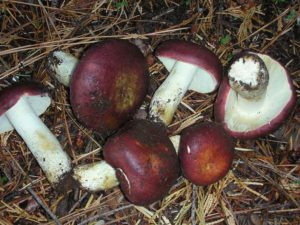
Russula are one of the most common mushrooms in our area. These gifts of the forest with multi-colored caps are usually not considered a delicacy, although their taste is in no way inferior to other mushrooms.
Every mushroom picker probably knows a russula. It is very difficult to confuse it with other species. The flesh of russula is very fragile and brittle, therefore some do not like to collect them, but in vain: fried, and salted, and russula stewed in sour cream are one of the most delicious mushrooms.
Brown russula (Russula xerampelina),
It is also known under other “speaking” names: aromatic russula and herring russula.
The russula grows brown in coniferous and deciduous forests. Forms mycorrhiza with a wide range of conifers and deciduous species. Occurs in July - September.
On the basis of color and confinement to a certain tree species, several of its varieties are distinguished:
Olive russula with a green or olive cap, grows mainly in pine forests, is rare and not abundant.
Another olive variety of russula, which grows brown with a lighter green or yellowish green cap, grows in birch forests.
The russula brownish red-footed with a dark red cap and a red leg, grows in coniferous, mainly pine forests, is relatively common.
The russula is brownish, burgundy with a purple, burgundy or wine-red cap, sometimes with a greenish tint. It grows mainly in oak and pine forests.
Brown russula has a pleasant nutty taste.
WHAT IT LOOKS LIKE:
Hat: up to 12 cm in diameter, at first semicircular, later convex and finally flat, The surface is dry, matte and soft velvety.
The color is very diverse and depends on which trees the russula grows brown. In the center of the cap, the color is usually darker. The skin is easily removable.
Plates: frequent, free, in young mushrooms whitish or milky-white, then brownish, to buffy, turning brown when pressed.
Leg: cylindrical, up to 8 cm long, up to 2.5 cm thick. In young specimens, it is solid, later hollow, white, often with a pink or red tint.
Pulp: vwhite or creamy at the beginning, turns brownish yellow on cut. The taste of young fruit bodies is slightly spicy, later nutty. Smell is a little more complicated.
Most mushroom pickers agree that the smell at the base of the stem is clearly herring. As for the hat, according to one, very authoritative sources, it is crab. Others, confidently recognize the smell of lobster. Well, I don’t know, I don’t know…. Let's dwell on the fact that it is "marine", with a predominance of herring.
The smell is stronger in older mushrooms. But when boiled, it almost completely disappears within 5-7 minutes.At boiling, however, will have to be patient, but someone may like it!
Similar species:
Representatives of the same genus Russula with red hats are similar to herring russula:
- Whole russula (Russula integra). Differs in tonality of color - the color of the cap combines blood-red, olive-yellow and brownish shades. Yellowish spots are visible at the base of the pinking leg. The pulp acquires a pungent taste with age.
- The russula golden-red (Russula aurata), in full accordance with the name, is painted in yellowish-red, brick colors, sometimes with purple hues. The pulp is odorless, sweetish.
- Almond russula or cherry laurel (Russula laurocerasi) has a cap of ocher, honey-brown tones, a burning taste and aroma of almonds.
It has no resemblance to inedible and poisonous mushrooms. .
Cooking Applications:
Brown russula is a good edible mushroom of the 3rd category.
This type of russula has excellent taste. All types of culinary processing and types of workpieces are suitable for him, except for drying.
Despite the unusual aroma, and perhaps thanks to it, in a number of European countries this type of russula is considered a delicacy.
And in Russia, some experts evaluate this mushroom as a delicacy because of its pleasant taste, and the smell is compared to lobster.
Despite the fact that russula are ignored by many mushroom pickers, it is still wrong to completely consign them to oblivion. Indeed, in the old days, salty russula in popularity were second only to milk mushrooms and mushrooms, which already speaks volumes.
Description
Whole russula (Russula integra) is edible, among the synonymous names it has the following: wonderful russula, brown-red russula, flawless russula.

- a cap with a sticky, shiny skin of a reddish-brown color. The color can vary from brownish to deep red, often the central part acquires an olive-yellow hue, sometimes fading to white. The minimum diameter of the cap is 4 cm, the largest is 12 cm. In the initial stages of development, the shape of the cap is convex hemispherical, later flat, depressed in the middle. The edges are wavy, often cracked, with radial grooves. The skin is removed only up to half of the cap;
- fleshy, infrequent plates adherent to the stem or loose. Light at first, later cream or ocher;
- spores are light ocher;
- the leg is cylindrical. Its maximum dimensions are up to 10 cm in length, up to 3 cm in thickness. Dense, solid at first, as it develops, it becomes spongy in the center. The color of the leg is white, often with a light pinkish bloom, with yellowish spots at the very bottom;
- firm brittle pulp is initially white. Its taste also changes over time: at first it is sweetish, later somewhat spicy. Has no distinct smell.

